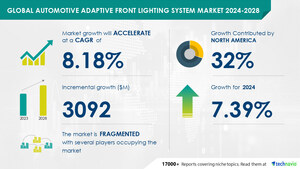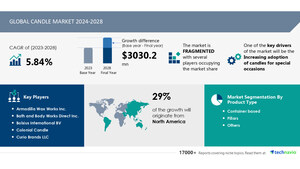NEW YORK, March 28, 2024 /PRNewswire/ -- The demand response (DR) market is set to witness substantial growth in the coming years, driven by advancements in technology and regulatory initiatives. With a forecasted increase of USD 2.90 billion between 2023 and 2028, the market is estimated to grow at a CAGR of 8.01%. This growth is attributed to various factors, including the emerging concept of the internet of things (IoT), increased generation of electricity from clean energy sources, and the advent of data-driven demand response solutions.
The report offers an up-to-date analysis of the market, and to know the exact growth variance and the Y-O-Y growth rate, Request a Free Sample Report.
Market Trends: A significant trend shaping the DR market is the increased generation of electricity from clean energy sources. Governments worldwide are imposing regulations to boost the percentage of energy generated from renewable sources, driving utilities to offer incentives for consumers to invest in clean energy solutions. This trend opens avenues for consumers to become energy producers, fostering the adoption of DR programs and solutions.
Report Coverage |
Details |
Page number |
182 |
Base year |
2023 |
Historic period |
2018-2022 |
Forecast period |
2024-2028 |
Growth momentum & CAGR |
Accelerate at a CAGR of 8.01% |
Market growth 2024-2028 |
USD 2.90 billion |
Market structure |
Fragmented |
YoY growth 2023-2024(%) |
7.25 |
Regional analysis |
North America, Europe, APAC, South America, and Middle East and Africa |
Performing market contribution |
North America at 60% |
Key countries |
US, Canada, China, Germany, and UK |
Largest-Growing Segments: The hardware and software segment emerges as the fastest-growing segment in the DR market. With advancements in technology, hardware- and software-based DR systems offer enhanced capabilities, empowering end-users to manage energy consumption efficiently. IoT implementation further fuels this segment's growth, providing opportunities for sophisticated solutions in industrial and commercial sectors.
Regional Analysis: North America dominates the DR market, contributing 60% to global growth. The US and Canada lead the region, driven by awareness among end-users about the benefits of DR programs and initiatives. Government support and collaboration between utility companies and DR aggregators further propel market growth in North America.
To learn more about this report - Request a Free Sample Report.
Key Drivers and Challenges: The increasing gap between electricity supply and demand serves as a key driver for market growth. Urbanization and population growth elevate the need for electricity, necessitating tools like DR to maintain reliability in energy systems. However, the growing threat of hacking poses a significant challenge to market expansion, highlighting the importance of stringent security measures in DR solutions.
Customer Landscape: The market research report covers the adoption lifecycle of DR solutions, offering insights into adoption rates and key purchase criteria across regions. Companies can leverage this information to develop effective growth strategies tailored to customer needs.
Major Market Players: Leading companies in the DR market include ABB Ltd., ALSTOM SA, Cisco Systems Inc., and Honeywell International Inc., among others. These companies employ various strategies such as strategic alliances and product launches to enhance their market presence and meet evolving customer demands.
Get a glance of this market - Request a Free Sample Report.
Market Analyst Overview: The DR market experiences substantial growth driven by technological advancements and regulatory frameworks, particularly in the US. Smart grid deployments enable bidirectional communication, facilitating energy management systems and integration of renewable energy sources. DR programs incentivize energy efficiency, reducing carbon emissions and enhancing grid stability.
Conclusion: With a favorable regulatory environment and technological advancements, the demand response market is poised for significant growth. Companies can capitalize on emerging trends and address challenges to seize opportunities in this dynamic landscape.
Analyst Review
The Demand Response (DR) market is experiencing dynamic growth, fueled by advancements in technology, regulatory frameworks, and a growing awareness of sustainability. DR programs are instrumental in enhancing grid stability, reducing carbon emissions, and optimizing energy consumption across residential, commercial, and industrial segments.
Key players in this market include building owners, homeowners, industrial consumers, and utility verticals, all of whom are leveraging smart grid roll-outs and automation in transmission and distribution (T&D) systems to implement DR solutions. Customer energy management systems, intelligent metering, and advanced ICT DSM solutions enable customers to participate actively in DR programs, particularly during peak demand periods.
The U.S. Green Building Council's Leadership in Energy and Environmental Design (LEED) certification plays a pivotal role in promoting energy management in buildings. The LEED DR Pilot program incentivizes building owners to adopt DR strategies by offering LEED credits for implementing energy-saving measures and integrating distributed energy resources (DERs) such as renewable energy and energy storage systems.
In the residential segment, homeowners can benefit from DR programs by adjusting their energy usage during peak requirements, supported by larger appliances equipped with smart grid technology. Commercial and industrial segments also stand to gain from DR initiatives, which offer flexibility and responsiveness to optimize energy usage and reduce costs.
Commercial demand response is facilitated by the integration of renewable energy sources and the deployment of electric vehicle charging stations, promoting sustainability and reducing reliance on traditional energy sources. Industrial consumers can leverage DR solutions to manage peak requirements and mitigate operational costs while contributing to grid stability.
Hardware technology improvements, including control equipment and metering devices, are driving industry growth by enabling bidirectional communication and seamless integration of DR systems. The U.S. smart demand response market is expanding rapidly, driven by advancements in energy efficiency and the need to address peak demand challenges.
Overall, the DR market is characterized by its ability to adapt to evolving energy landscapes, offering a pathway towards grid modernization, reduced carbon emissions, and enhanced sustainability. As smart grid deployment continues to proliferate, the integration of DR programs will play a crucial role in shaping the future of energy management and consumption.
Get a glance of this market - Request a Free Sample Report.
ToC:
1 Executive Summary
2 Landscape
3 Sizing
4 Historic Size
5 Five Forces Analysis
6 Segmentations
7 Customer Landscape
8 Geographic Landscape
9 Drivers, Challenges, and Trends
10 Vendor Landscape
11 Vendor Analysis
12 Appendix
About Technavio
Technavio is a leading global technology research and advisory company. Their research and analysis focus on emerging market trends and provide actionable insights to help businesses identify market opportunities and develop effective strategies to optimize their market positions.
With over 500 specialized analysts, Technavio's report library consists of more than 17,000 reports and counting, covering 800 technologies, spanning 50 countries. Their client base consists of enterprises of all sizes, including more than 100 Fortune 500 companies. This growing client base relies on Technavio's comprehensive coverage, extensive research, and actionable market insights to identify opportunities in existing and potential markets and assess their competitive positions within changing market scenarios.
Contacts
Technavio Research
Jesse Maida
Media & Marketing Executive
US: +1 844 364 1100
UK: +44 203 893 3200
Email: [email protected]
Website: www.technavio.com
SOURCE Technavio

WANT YOUR COMPANY'S NEWS FEATURED ON PRNEWSWIRE.COM?
Newsrooms &
Influencers
Digital Media
Outlets
Journalists
Opted In






Share this article